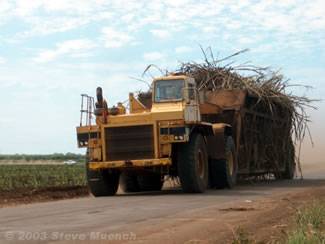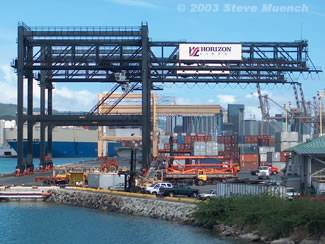Heavy Industrial Facilities
"Heavy industrial facilities" encompasses any facility for use with heavily loaded vehicles such as industrial drives, truck parking, bus terminals, warehouse loading areas, log storage areas and container lots. HMA is a durable, high-strength pavement material that is entirely appropriate for industrial facilities.
One of the chief advantages of HMA in industrial facility paving is its short construction time. During paving operations, industrial facilities often cannot be used and thus the owner incurs a financial loss for the duration of the paving project. Unlike rigid pavements, which may take from several days to several weeks to construct, a flexible pavement can usually be constructed in one working day or less thus minimizing the facility down-time.
 |
 |
Figure
1: Cane haul road on Maui. |
Figure
2: Honolulu Harbor terminal. |
Assumed Traffic
Traffic for these types of facilities cannot be assumed. A
methodical and reasonably accurate estimation of the type and
number of loads is
essential in determining the proper pavement structural
design, mix
type and mix
design. Sometimes, intended
industrial traffic is well beyond legal load limits for Hawai'i
State highways, such as on a cane haul road.
Design Considerations
The types and number of loads can vary widely requiring widely
varying designs. Industrial applications often require heavy
duty mixes to ensure resistance to loading such as tracked
vehicles, stacked containers, stationary turning operations
and abrasive forces. A heavy duty mix is a dense-graded
mix containing large nominal
maximum aggregate sizes, usually between
0.75 and 1.5 inches (NAPA, 2002). 0.75 inch or larger Superpave
and State
Mix III can be used
as a heavy duty mix. Heavy duty mixes provide for
superior load
carrying characteristics due to the improved aggregate interlock
of the paving mixture matrix. Because of the reduced surface
area of the mix, the percentage of liquid asphalt binder is
lower in these mixes, providing a very good value and very “tough” mixes.
The final few lifts of a heavy load paving design should still
utilize smaller aggregate sized hot mix for proper sealing
and a tight surface texture for the final product. Polymer modified
asphalt
binders can also be incorporated in heavy
load applications to further increase the pavement structure’s
load carrying capacity.
Construction Considerations
There are three principal challenges that arise when using
heavy duty mixes (Texas Transportation Institute, 1997):
- Segregation. The single most common problem with large-stone mixes (NAPA, 2002). These mixes are more prone to segregation than finer mixes because the larger aggregate sizes vary greatly in the mix (TTI, 1997).
- Aggregate fracture. Larger aggregate particles may break down in the manufacturing or compaction processes if they are not sufficiently hard. This can affect gradation and other mixture characteristics.
- Equipment wear. Larger aggregate particles may create additional wear on the manufacturing plant as well as the laydown and compaction equipment.
- National Asphalt Pavement Association (NAPA). (2002). Design, Construction, and Performance of Heavy Duty Mixes, Quality Improvement Series 123. National Asphalt Pavement Association. Landham, MD. (www.hotmix.org)
- The Asphalt Institute. (1986). Thickness Design - Asphalt Pavements for Heavy Wheel Loads, Manual Series No. 23. The Asphalt Institute. Lexington, KY. (www.asphaltinstitute.org)
Recommended Minimum Pavement Thickness and Design (inches)
To be determined using an approved procedure.


